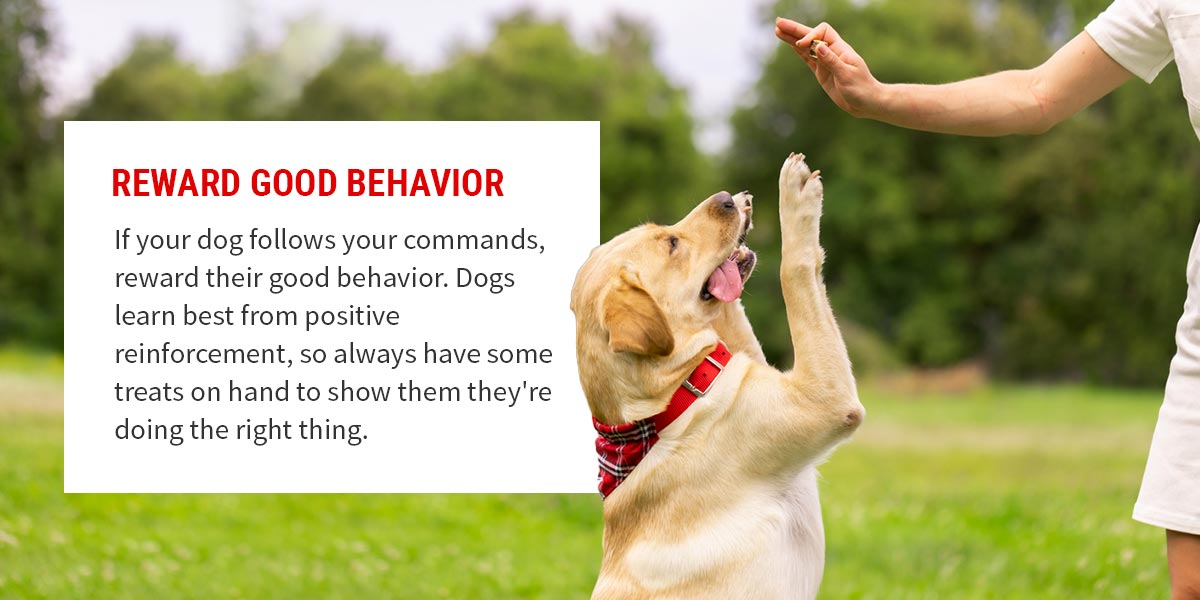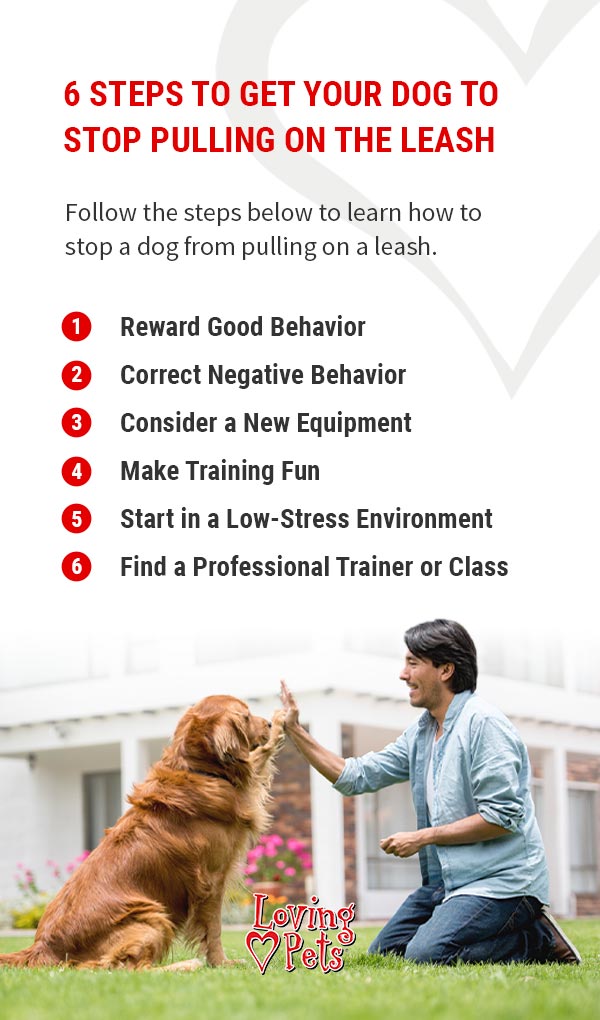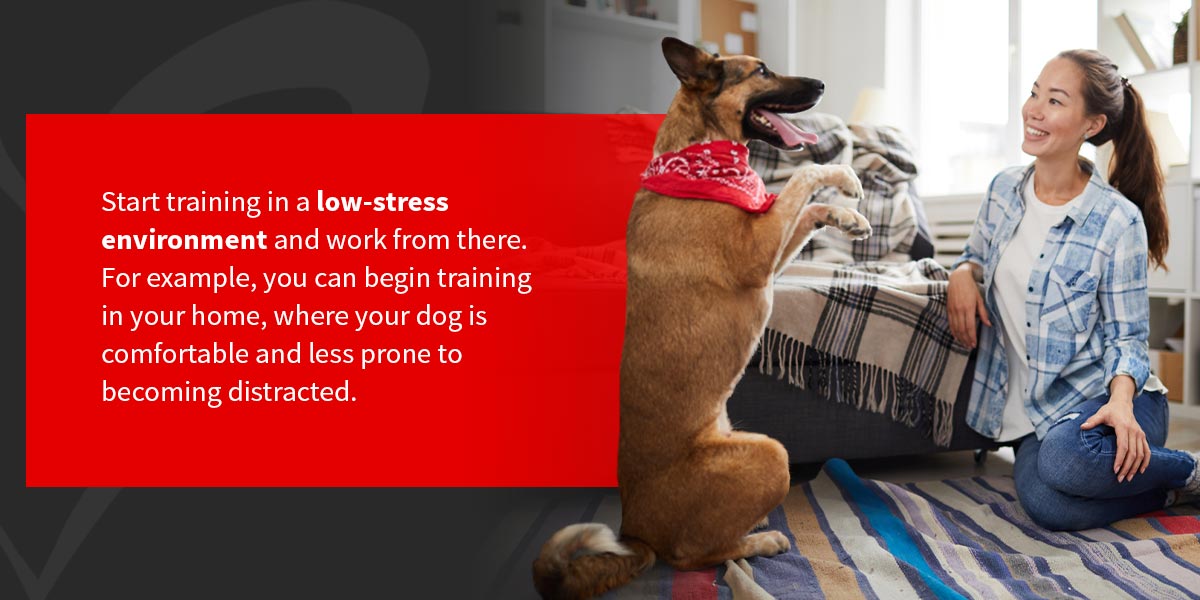How to Stop Your Dog From Pulling on the Leash
When your dog pulls on the leash during walks, it can be stressful, turning a pleasant outing with them into a frustrating day. If your pup does this, you may even avoid taking them on walks except for the necessary bathroom breaks. The good news is there are ways you can train your dog to stop them from pulling on the leash.
To improve your dog's leash-walking behavior, you must first learn proper positioning, mechanics and communication. You may also need a training collar and a stronger leash. Learn more below about how to stop a dog from pulling on a leash.
6 Steps to Get Your Dog to Stop Pulling on the Leash
Many dogs pull their leashes due to exposure to stimuli or stressors, such as other dogs, people, squirrels or cars. Luckily, there are ways you can train your dog to stop leash pulling, helping you turn chaotic walks into a peaceful experience. Follow the steps below to learn how to stop a dog from pulling on a leash.

1. Reward Good Behavior
When starting leash training, insist that your dog remains in “heel position,” whereby they are on your left side with their right shoulder even with your left leg. Allow a grace distance of 6 inches to the front, 6 inches to the rear and 12 inches to the left side. When your dog remains alongside you in the heel position, keep your arms relaxed and your leash loose.
If your dog follows your commands, reward their good behavior. Dogs learn best from positive reinforcement, so always have some treats on hand to show them they're doing the right thing. You can also hold treats in your left hand to help your dog get into the correct position, rewarding them once they perform the proper action.
Rewarding good behavior, such as when your dog stays by your side and is attentive to you and your actions, will help reinforce this behavior. Eventually, these actions will become a habit for your dog, and you won't have to carry treats for your pup to stay by your side.
However, some dogs aren't food motivated, so you'll have to find an alternative reward method. These methods can include petting, playtime and praise. Find out what motivates your dog best or catches their attention and use that to aid you as you're leash training.
2. Correct Negative Behavior
Using rewards for positive behaviors can be challenging for dogs who are easily distracted, compulsive pullers or disinterested in rewards. Mild punishments or corrective behaviors can help you in the leash training process if your dog falls into one of these categories.
First, check that your leash is loose when your dog is in position. A tight leash ironically promotes pulling, whereas a loose leash reduces the probability of pulling. If loosening the leash is insufficient, correct the dog with a sharp leash pop whenever they move outside the heel position.
Correct silently. Do not verbally admonish your dog. Restrict your verbal communication solely to delivering the initial “walk” command and to praise. If your dog is small or generally cooperative, a light correction rearward is all that is required. A harder two-handed correction may be necessary with stronger or more stubborn dogs.
After you correct with the rearward leash pop, the dog should return to the heel position. Once they return to the heel position, immediately loosen the leash and praise.
If your dog gets distracted easily by cars, people or dogs, you can also recorrect their behavior. Remember to stay calm, as frustration can rile up your dog. If you notice one of your dog's triggers approaching during your walk, try walking to a safe area where you can wait until the distraction passes. Keep your dog focused on you, so they don't bark or try to pull on the leash. If your dog can let the trigger pass without event, reward your dog to show them they're behaving correctly.

3. Consider a New Equipment
If the preceding is insufficient and your dog is still pulling on the leash, you may need to improve your equipment. You might want to switch to a leather leash if you're using a standard leash.
Leather is stronger and softer on your hands than leashes made of nylon, cloth or chain. Leather leashes also offer increased dexterity compared to retractable leashes. We recommend 6-foot leashes for small dogs and 3.5- to 4-foot leashes for large dogs. Harnesses are another effective tool you can try. Some harnesses will pull your dog's body toward you when they pull without choking them.
You can also change your dog's collar to stop your dog from pulling the leash. A pinch collar or gentle leader head halter can help improve pulling behavior. Start training with the new collar at home in a calm environment to help them adjust. Once your dog has made improvements in your home, you can progress slowly outside, such as down the driveway or in public areas that don't often contain distractions.
4. Make Training Fun
Leash training should be fun for you and your dog. You can play games as a training method, such as red light, green light. When your dog walks ahead of you, come to a stop and wait for your dog to stop pulling. Wait for your pup to come back to your side. Once your dog is focused on you, continue walking. You can find many training games online to help make leash training enjoyable for you and your pup.
You should also create rewards for yourself when your efforts with your dog work. For example, if your dog responds well to training inside your home, you can reward yourself and your pup with a more invigorating walk in a local park.

5. Start in a Low-Stress Environment
As mentioned, your dog might have triggers that make it challenging to train in public. Some dogs are reactive toward other dogs, people, cars and wildlife. These triggers make it challenging to focus your dog's attention on you.
First, you should start training in a low-stress environment and work from there. For example, you can begin training in your home, where your dog is comfortable and less prone to becoming distracted. Once your dog responds well to your commands in your home, try advancing to your driveway or sidewalk, working on managing your dog's excitement to new stimuli.
Eventually, your dog will get the hang of standing by your side, even when they're walking outside. Once your dog can walk down the driveway or sidewalk, you can try walking in a park or similarly busy area, so your dog can get used to walking without pulling in an area with plenty of distractions.
6. Find a Professional Trainer or Class
If your dog still pulls on the leash after trying the steps above, you can seek a professional trainer or class. A certified dog trainer or behavioral specialist can help you identify why your dog behaves in a specific way and what solutions you can try.
A professional can provide feedback regarding your training process, giving you alternatives if something you're doing isn't working. Attending a class is also a great way to expose your dog to other dogs and people, helping reduce the impact of their triggers.
Leash Train Your Dog With High-Quality Treats
Treats are an excellent way to positively reinforce good behavior, especially when leash training. Loving Pets has a wide selection of quality training treats to help you along your leash-training journey. Our Houndations treat bags come with a carabiner so that you can attach the bag to your belt loop, making it easy to access while you're training. Our treats are soft and bite-sized, making them easy to eat quickly and allowing for more opportunities for positive reinforcement.
Our treats utilize some of the best ingredients that your dog will love. We offer different flavors to suit your dog's preferences, including chicken, beef, duck, salmon and lamb. Browse our selection of training treats or explore our other dog treats and bones or chews today!




